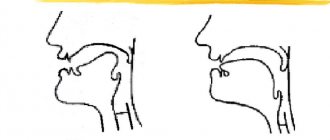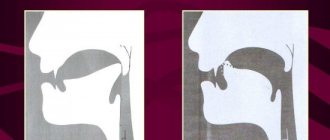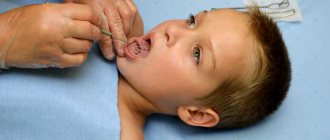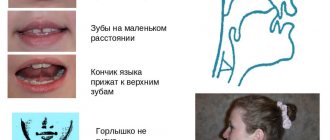Types of sound violations [Р] and [Рь]
- No sound.
The sound is devoid of its inherent articulation, as evidenced in speech by the lengthening of the adjacent vowel. - Replacing sounds
(pararotacisms) with other sounds. - Distortions of sounds (rhotacism).
Types of rhotacisms:
velar
- the tongue does not take part in articulation, the soft palate vibrates.
The pronunciation resembles the French [P]; uvular
- it is not the tongue that vibrates, but the uvula (small tongue);
nasal
– a combination of sounds [N] and [G] is heard;
lateral
– a “squelching” sound is heard;
buccal
– when exhaling, the cheeks swell;
coachman
- closed lips vibrate;
bilabial
- the sound is similar to English [W];
single-impact
- the tip of the tongue does not vibrate, but only hits the alveoli once. - Mixing sounds
- more often [P] and [L]; [Ry] and [L]; [P] and [Y]; [Rb] and [Y].
www.Logopedy.ru
Spesivova Ninel Evgenievna, speech therapist of the State Healthcare Institution SO "Atkarskaya RB", Atkarsk, Saratov region.
Original:
Certificate of publication: not issued
One of the most common and most difficult defects in sound pronunciation to correct is a violation of the pronunciation of the sound R. “R” is a consonant, oral, hard, voiced, vibrant, lingual-alveolar sound.
The normal position of the organs of articulation when pronouncing the sound “R”. The lips are open and take the position of the next vowel. The distance between the teeth is approximately 4-5mm. The tip of the tongue rises to the base of the upper teeth. It is tense and vibrates in the passing air stream. The anterior-middle part of the back of the tongue bends. The back of the tongue is pushed back and rises slightly towards the soft palate. The lateral edges of the tongue are pressed against the upper molars, the vocal-exhalatory stream passes through the middle. The soft palate is raised and closes the passage to the nose. The vocal cords are closed and vibrate.
A strong air stream breaks the bridge of the tip of the tongue and the palate, the tongue vibrates.
The soft sound “R” differs from the hard one in that when it is articulated, the middle part of the back of the tongue rises to the hard palate (approximately as with the vowel “I”), the tip of the tongue is slightly lower than with a hard “R”, the back of the back of the tongue moved forward along with the root.
Disadvantages of pronunciation of the sound “R” (rhotacism).
Velar pronunciation. With velar articulation, a gap is formed at the point where the root of the tongue approaches the soft palate; exhaled air, passing through this gap, causes random multi-impact vibration of the soft palate. As a result, noise arises that mixes with the tone of the voice.
Uvelar pronunciation. With the uvelar “P,” only the small tongue vibrates; vibration is harmonious and not accompanied by noise.
Lateral rotacism. With this disorder, only one of the lateral edges of the tongue vibrates, the closure between the tongue and the molars breaks, and a vocal-exhalatory stream emerges through it, as with the sound “L”, as a result a sound is pronounced in which “R” and “L” seem to merge "
With the “ cheek ” pronunciation of “P”, a gap for the exhaled stream of air is formed between the lateral edge of the tongue and the upper molars, as a result of which the cheek vibrates (vibrates). At the same time, noise is superimposed on the tone of voice. Rarely, the disorder is bilateral.
One-beat pronunciation of "R". With it, there is no vibration, but the place of articulation is the same as with a normally pronounced sound.
" Kucherskoe " "R". In this case, the lips brought together vibrate.
Dull pronunciation of the sound “R”. The sound is pronounced without the participation of the voice, the vocal cords are open and do not vibrate. Replacing the sound “R” with a paired soft “R”, as well as “L”, “Y”, “D”, “V”, “G”, “Y”, etc.
The soft “R” can be broken in the same way as the hard one, but at the same time there are often cases when only the hard sound is broken, and the soft one turns out to be unbroken.
I will describe the “P” sound correction technique that I use in my practice. Articulation gymnastics exercises at the preparatory stage of correction “P”: “Smile”. Keeping your lips in a smile. The teeth are not visible.
"Fence". The upper and lower teeth are exposed. The lips are stretched into a smile.
"Tube". Pulling the lips forward with a long tube.
"Proboscis". Pulling closed lips forward.
"Bagel". The teeth are closed. The lips are rounded and slightly extended forward. The upper and lower incisors are visible.
"Rabbit". The teeth are closed. The upper lip is raised and exposes the upper incisors.
"Brush your teeth". Mouth closed. Move your tongue in a circular motion between your lips and teeth.
“Let’s lick our lips.” The mouth is slightly open. Lick your lips in a circle.
"Put the ball into the goal." Pull your lips forward with a tube and blow on the cotton ball for a long time, pushing it between two cubes.
"Spatula". The mouth is open, a wide, relaxed tongue rests on the lower lip.
"Cup". The mouth is wide open. The anterior and lateral edges of the wide tongue are raised, but do not touch the teeth.
"Needle." The mouth is open. The narrow tongue is pushed forward.
"Watch." The mouth is slightly open. The lips are stretched into a smile. Using the tip of your narrow tongue, alternately reach to the corners of your mouth at the speech therapist’s direction.
"Focus". Open your mouth slightly, stick your tongue out with a cup forward and lift it, exhale smoothly onto the cotton wool lying on the tip of your nose.
"Painter". The mouth is open. Using the wide tip of the tongue, like a brush, we move from the upper incisors to the soft palate.
"Delicious jam." The mouth is open. Using a wide tongue, lick your upper lip and move your tongue into the back of your mouth.
"Fungus". The mouth is open. Suck your tongue to the roof of your mouth.
"Harmonic". The mouth is open, the tongue is sucked to the roof of the mouth. Without lifting your tongue from the roof of your mouth, strongly pull down your lower jaw.
"Horse". Suck your tongue to the roof of your mouth and click your tongue. Click slowly and firmly, pulling the hyoid ligament.
"Coil". The mouth is open. The tip of the tongue rests on the lower incisors. The lateral edges are pressed against the upper molars. The wide tongue “rolls out” forward and retracts into the depths of the mouth.
"Drummers" Smile, open your mouth and tap the tip of your tongue on the alveoli, repeatedly and clearly pronouncing “d-d-d”, then with the rhythm d-d-ddddd.
"Chatterbox." Open your mouth slightly, vigorously run the wide front edge of your tongue along your upper lip back and forth, trying not to lift your tongue from your lip, add your voice until you hear: “drr.”
Staging methods. 1. By imitation. The speech therapist explains the correct articulation of the sound, then pronounces the sound, and the child imitates it.
2. Setting the sound [P] from the exercise “CHATTER”. The child does the “Chatterer” (or “Turkey”) exercise: sticking out a wide tongue on the sound [Y] makes movements back and forth, sliding along the hard palate. At the moment when the tongue touches the alveoli, a single-beat [P] is heard. Fix this position and begin automation [P]. Very soon the single-beat sound itself turns into vibrant (the tip of the tongue trembles).
3. Method of setting the sound [P] from the exercise “Mushroom”. The child sucks his tongue to the hard palate (“Fungus”); takes a deep breath through the nose (tongue in the same position); makes a sharp short exhalation through the mouth, directing the air stream to the tongue and connecting the voice.. The effect is achieved by contrast (tongue tension during suction and relaxation during a sharp exhalation). This helps to vibrate the tip of the tongue.
4. Setting [P] from the sound [Zh]. The child pronounces the sound [Zh] for a long time, on one exhalation, and at the same time moves the tip of the tongue back and forth along the alveoli “BURPLES”. At the same time, you can hear a single-strike [P]. After fixing the isolated pronunciation of this sound, they move on to pronouncing syllables with the combination of ZhR, DR, NR, TR. This contributes to the rapid transfer of a single-beat [P] into a state of vibrating sound.
5. Setting [P] from the sound [D] or the syllable DY at a fast pace, possibly with a given rhythm D D DDDDD. The sound or syllable is pronounced at the alveoli. The ball probe makes quick movements under the tip of the tongue to the right and left. The result is the sound combination DR or DRA. The vibration is worked out until it is independent. Then we remove the reference sound D, first put it with other consonants BR, MR, and then without them.
6. Setting [P] with insufficient air flow. The method is suitable for those children who do not generate an air stream of sufficient power necessary to vibrate the tip of the tongue. The peculiarity is that the child is in a semi-lying position, with his head slightly thrown back. The tongue is raised up towards the alveoli, the child pronounces the sound [D] at a fast pace. The probe makes quick movements under the tip of the tongue to the right and left. The effect is achieved by the fact that in the supine position the tongue is slightly pulled back and the child is forced to exhale a stream of air more intensely, which starts the vibration in combination with the manipulations of the probe.
7. Setting [P] from the interdental position. The wide edge of the tongue on the upper lip. In this position, the child is asked to blow on the tip of his nose with a buzzing sound similar to “B-B-B.” Use your index finger to “play” on the child’s lower lip, as a result of which the air stream becomes vibrating. Then gradually reduce the duration of the finger touch, then removing it, then returning. Achieve a vibrating sound from the slightest touch on the lower lip “v-v-r-r-e-uh...” • Keeping the same configuration of the tongue, move it behind the upper teeth.
8. If the sound [P] is replaced by its soft pair, then you can achieve a firm pronunciation of the sound as follows: the child is asked to pronounce “Pb” protractedly while expanding his mouth, which causes the tip of the tongue to automatically move back and the sound becomes hard.
9. Setting [P] from the combination [TD]. The child is asked to take turns pronouncing the sounds [T] and [D] in combination [TD] or [TDD] at a fast pace and rhythmically. They are articulated when the mouth is slightly open and when the tongue is closed not with the incisors, but with the gums of the upper incisors or alveoli. When repeatedly pronouncing a series of sounds [D] and [T], the child is asked to blow strongly on the tip of the tongue, and at this moment vibration occurs.
10. Production [Рь]. A long, rolling [P] is successively combined with the vowels [I], Ya, E, Yu, while stretching the lips into a smile. Having achieved the correct pronunciation of [Рь] in syllables, words are introduced, etc.
Automation of the sound R in syllables, words and sentences.
1. In open syllables RY RE RA RO RU:
Some tasks: Repeat the syllable; Complete the syllable: go RY, but RA, pe RO, keg RU...; Say with different accents: ry ry ry, RE re re, ra RA RA...; Start a word.
2. In closed syllables YR ER AR OR UR:
3. In the position between the vowels YRY ERE ARA ORO URU;
4. In syllables with consonant swelling BRA BRE BRY BRO BOU and so on with other consonants in the first place.
5. At the beginning of the word in the open syllable CANCER MOUTH LYNX RUDDER, etc. in two or three syllable words.
Some tasks: Repeat RA RA CANCER, etc.; Count from 1 to 5 FISH, RUBLE, etc.; Name the pictures; Say ROCKET with your eyes closed as many times as you hear pops; Say CHAMOMILE with the word NO (I give, I see, I admire) NO CHAMOMILE, etc.; Change the word COMB-COMBS, etc.; Complete the word RA RA RA – TRUMBE (trumpet), etc. Match the word to the diagram (pictures are provided). Come up with a word for the diagram. “Gather your relatives” HAND - handles, handmade, sleeves, etc. Answer the question in a word: Pear juice. Which one? PEAR.
6. In the middle of the word in the open syllable are MOUNTAINS, PIE, RAM, etc. with complication.
7. At the end of the words CHEESE, SIR, STEAM, CHORUS, etc. with complication.
8. In the middle of a word in a closed syllable WATERMELON, THERMOS, GRATER, MAGAZINE, etc.
9. In words with a combination of consonants in the first syllable, THUNDER, PAINT, CONSTRUCTION, SUDDENLY.
10. In words with a combination of consonants in the middle COBRA, KINDNESS, VATRUSHKA, etc.
11. In the “rich” words TRACTOR, ICE PILE, TEST TUBE, PROSECUTOR, etc.
12.In a sentence:
Some tasks: Repeat the saying RA RA RA – IT’S TIME TO GO TO THE PARADE, etc. “Poet” come up with a simple saying RY RY RY - (bitten by mosquitoes), etc. Repeat the sentence from the picture for the speech therapist. Remember and say a sentence based on the picture yourself. Compose and repeat a sentence using a picture, using a mnemonic table, using supporting words, using given words, using a diagram. Correct the sentence “Confusion” Change the sentence I’M DIGGING A GARDEN, (you..., he..., she..., we..., you..., they...) Make a sentence for the diagram based on the picture, etc. “Grow” a sentence by adding words. Remember and repeat the proverb, saying. Explain the meaning.
Further, the sound is automated in phrasal speech (poems, retellings, stories, conversations). I wish you success!
Social commentary Cackle
Causes of impaired pronunciation of “vibrants”
Bridle trimming?
A commonly practiced method in the past that I often hear from parents to this day is cutting the hyoid ligament (frenulum). I would like to note that such drastic measures cannot always lead to the desired result - the appearance of the sound [P]. I categorically do not recommend cutting the frenulum unless there is a medical indication for it. The absence of this sound is associated with general weakness of the tongue muscles and underdevelopment of the hyoid ligament. This is why the child is not able to lift his tongue and press it tightly to the palate. Follow the tips above, and the desired results will not keep you waiting.
Good luck to you and your kids!
Speech therapist Alena.
Bogomolova method
A.I. Bogomolova in 1979 proposed a method for generating vibration for saying “R”. The teeth are open to a distance of 2 fingers. The tongue is pressed against the palate, stretching the frenulum as much as possible. The teacher moves the edges of the tongue towards the palate with his fingers, while the frenulum is free.
The child takes a deep breath and blows it out sharply, using his voice. The combination “TZ” is formed. Repeat the exercise, gradually increasing the air pressure. The sound combination “TLE” will change to “TR”. After fixing the short “TR”, they practice the rolling “TR” with the help of fingers, and then without them.
Sound Automation
In order to put the sound “r” and consolidate your achievement, perform exercises to automate the sound: learn and pronounce tongue twisters, rhymes, and tongue twisters.
The production of the soft sound “r” is done after the pronunciation of the hard “r” is fixed.
Exercises for pronouncing the letter “r” in this case are pure phrases with a soft “r”:
Tongue twisters are great for putting a soft “r”
Various tongue twisters and nursery rhymes will become additional practice and will help the child consolidate the acquired skills in pronouncing the letter R. They will also develop general articulation, besides, this funny type of repetition always gives children great pleasure and charges them with a positive attitude.
Exercises with tongue twisters can be carried out in the form of competitions between the baby and other family members, regardless of how old someone is. Examples of tongue twisters:
Speech exercises
For the development of the speech apparatus, general language gymnastics is necessary. It must take place in a playful way. 3-4 times a day for 10-15 minutes. The baby needs to be interested so that he has a desire to do this gymnastics. How to do this is the concern of each parent individually.
So, let's look at an approximate set of exercises.
- Exercise 1: play a game with your child to see who can reach the tip of their nose with their tongue
- Exercise 2: roll your tongue into a tube, stick it out of your mouth and blow into your tongue
- Exercise 3: use the tip of your tongue to reach your upper teeth and say the letter “d”
- Exercise 4: play around with your tongue, stick it out of your mouth and swing it in one direction and the other.
- Exercise 5: tell your baby that your tongue is a toothbrush, and you need to brush all your teeth with it on all sides.
In addition to these exercises, parents can come up with others, the main thing is that they are done in a playful way and the child likes them.
Do not require your child to immediately pronounce words with the letter r. Start with simple ones, gradually moving to more complex ones. Try to show him how to growl first, and let him repeat it. Then, if you already get a single letter “r”, practice saying syllables with this letter “ra, ro, ri, re, rya, ru”. And after syllables have begun to form, you can move on to words with the letter “r”.
Don’t forget that an important point when working with children is psychological. A 5-year-old child is already big and notices his defect himself; it is possible that his peers constantly tell him about it. Therefore, the main thing is not to “overdo it”. During classes, encourage the child and praise him.
Note to parents. Don’t despair, if you have confidence in your abilities, in the abilities of your baby, then he will try and everything will work out for him.
Why can't my child pronounce the letter "r"?
Many parents face the problem of their children not pronouncing sounds, especially “r”. The reasons for this phenomenon can be very different:
- Anatomical. Some children have developmental abnormalities of the speech apparatus. Some may affect their ability to pronounce sounds:
- poor tongue mobility;
- malocclusion;
- poorly developed muscles of the cheeks and lips.
abnormal structure of the hyoid frenulum;
Fixing such problems is quite difficult. Special articulation gymnastics and frenulum stretching will help with this. In some cases, surgery is required.
- Features of sound perception . In this case, children often confuse letters, rearrange them, and replace some sounds with others. The cause may be a disorder of phonetic hearing - when the baby does not perceive certain sounds.
Also, such a violation may be associated with imitation of someone from a close environment (for example, an older brother burrs, and the baby copies his speech).
- Problems with ENT organs. They can be triggered by breathing problems (weak inhalation) or diseases of the ear, nose and throat. Diseases that can provoke a violation of the pronunciation of sounds:
- allergic rhinitis;
- previous sore throat;
- the presence of adenoids or polyps in the throat;
- paresis of ENT organs.
tonsillitis;
In this case, individual treatment is selected to combat the underlying disease. Children will also need to select a set of speech therapy exercises to restore speech functions.
The psychological causes of speech impairment are highlighted separately. In this case, consultation with a psychotherapist is required.
Hearing impairment
Phonemic hearing is the ability to distinguish, analyze and differentiate heard phonemes. From birth, children master their native speech by imitation. By the age of 4, a preschooler has developed the technique of pronunciation of all sounds, except sonorous ones.
Impaired phonemic hearing (dyslalia) complicates the perception of oral and written speech in school education, therefore, correction of defects is necessary as soon as they are detected.
Speech therapy exercises for the development of phonemic hearing, which parents can do independently:
- The adult names a series of sounds, and the child claps his hands when he hears the one in question.
- The adult claps his hands or taps a pencil in a rhythm that the child must repeat.
- The adult dictates sound combinations, the child repeats them.
- The adult shows the pictures, the child chooses those with the hidden sound.
- The adult names the words correctly and incorrectly, the child claps his hands when he hears the correct option.
Automation of the letter "P".
Speech breathing problems
Speech breathing is the basis of spoken speech. It is responsible for voice-forming and articulatory functions. Speech breathing is the ability of a person to take a short, deep breath and distribute the air when exhaling while simultaneously pronouncing various sounds. Inhalation is 5-8 times shorter than exhalation. The long-term output is where speech is formed. With correct speech breathing, the child speaks clearly and expressively, observing pauses.
Preschoolers do not control themselves, they begin to speak while inhaling or on the residual output, and take in air before pronouncing each word. This affects correct pronunciation. If the child does not pronounce “R”, correction work should begin with breathing.
How to teach correctly. Speech therapist advice
So, how to quickly teach a child to say the letter “r”?
Parents do not always have the opportunity to show their child to a speech therapist, and often finding a free speech therapist who can work with the child is not so easy.
If the baby pronounces other sounds well and only “r” remains problematic, then you can try to create the sound by practicing yourself.
In order to successfully develop the baby’s speech apparatus, speech therapists recommend adhering to the following rules:
- You need to master the letter gradually. First, we teach how to pronounce the syllables correctly: ar, ra, op, ro and so on. After this, you can master complex tongue twisters.
- Try to interest the child. Gymnastics must be done in a playful way. The exercises should captivate the baby so that he does them with pleasure.
- Classes must be held regularly. Several lessons may not be enough to produce the “r” sound. It is necessary to do gymnastics every day.
Often they start teaching a child tongue twisters to make a certain sound. This is not true. First you need to master the sound separately.
After this, achieve the correct pronunciation of simple syllables with this sound. Then we fix the sound in the pronunciation of short, easy words. And only after this we begin to memorize tongue twisters to develop automaticity when pronouncing the sound “r”.
Who can teach a child to say the letter R?
The speech therapist will play one of the most important roles in the formation of the baby’s speech. However, the most important participants in the process will be parents. The success or failure of training depends on them.
It should be understood that to correctly form pronunciation you need to put in much more effort than, for example, learning to swim. Indeed, in the case of words, the emphasis is not on technique, but on the development of the articulatory apparatus. Therefore, parents should:
– create a schedule of activities with your child;
– do not miss a single day of training;
– choose the most interesting and exciting games and exercises;
– make classes fun;
– have incentive gifts on hand;
– be patient for a couple of months in advance;
– don’t expect quick results.
Only after this can we talk about parents’ readiness to help their child correct their pronunciation.







